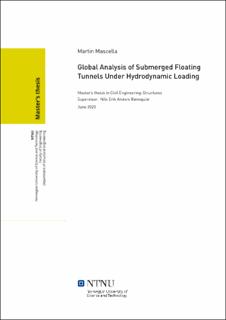| dc.description.abstract | This master’s thesis includes several preliminary designs of Submerged Floating Tunnels
(SFT) and its responses to hydrodynamic loading. SFT is a never built transport structure,
which can be use for crossing lakes, straights or fjords. In this thesis are considered tether
stabilized SFTs , which requires deep water foundations too.
Generally, deep water foundations and anchoring system installation are highly dependent
on the water depth and soil characteristics, and they might not be feasible for really deep
waters. In this thesis project case studies are carried out in order to eventually reduce the
number of necessary tethers.
First, a detailed literature review of existing SFT designs and reports is included. It focuses
on the differences and similarities of the concepts, different proposed tunnel cross-sections,
supporting systems and tunnel alignments are compared.
The thesis aim is to identify the effects of the tunnel alignment on the structural response. A
conceptual design is performed using simplified methods and literature recommendations.
Simple and effective draft designs are obtained in this phase.
Four different design concepts are developed. Three models have a double curvature configuration of the tunnel and they differ in the tether arrangment and number, and buoyancy
weight ratio. One model is a straight SFT with vertical tethers at mid-span. In one model
also a pulley connection between the tethers and the tunnel is implemented.
Static, modal and dynamic analysis have been performed using both the software Abaqus,
and analytical methods. Through the static analysis, which neglects the fluid-structure interaction, is highlighted the dependence of each model on the buoyancy weight ratio amplitude. A non-conservative harmonic regular wave dynamic analysis is performed on the
four models in order to compare their responses. This analysis is also compared to an
irregular wave analysis in order to demonstrate that the assumptions made during the harmonic analysis are highly conservative. Sensitivity tests on the loading conditions and the
end connection stiffness are performed. It results suitable a stiffness in between the pin
and the clamped connections. Overall it appears that the double arch configuration has a
sufficient lateral stiffness and so inclined tethers are not needed. Moreover the structural
dynamic oscillations are reduced adopting a double curvature in comparison to a straight
tunnel configuration | |
